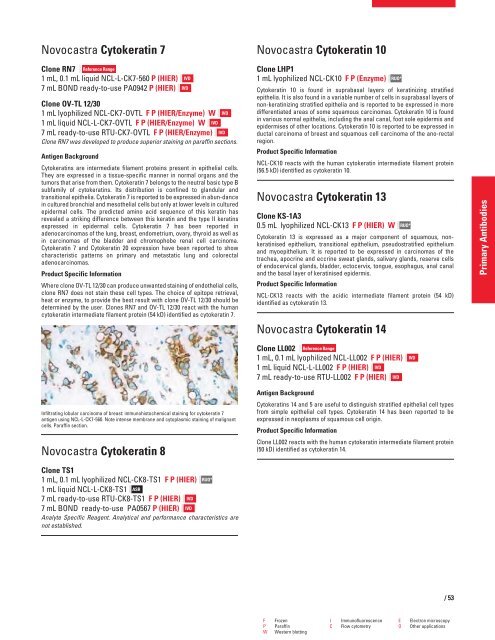QF0159 Marketing Release Record
QF0159 Marketing Release Record
QF0159 Marketing Release Record
Create successful ePaper yourself
Turn your PDF publications into a flip-book with our unique Google optimized e-Paper software.
Novocastra Cytokeratin 7<br />
Clone RN7 Reference Range<br />
1 mL, 0.1 mL liquid NCL-L-CK7-560 P (HIER)<br />
7 mL BOND ready-to-use PA0942 P (HIER)<br />
Clone OV-TL 12/30<br />
1 mL lyophilized NCL-CK7-OVTL F P (HIER/Enzyme) W IVD<br />
1 mL liquid NCL-L-CK7-OVTL F P (HIER/Enzyme) W IVD<br />
7 mL ready-to-use RTU-CK7-OVTL F P (HIER/Enzyme) IVD<br />
Clone RN7 was developed to produce superior staining on paraffin sections.<br />
Antigen Background<br />
Cytokeratins are intermediate filament proteins present in epithelial cells.<br />
They are expressed in a tissue-specific manner in normal organs and the<br />
tumors that arise from them. Cytokeratin 7 belongs to the neutral basic type B<br />
subfamily of cytokeratins. Its distribution is confined to glandular and<br />
transitional epithelia. Cytokeratin 7 is reported to be expressed in abun-dance<br />
in cultured bronchial and mesothelial cells but only at lower levels in cultured<br />
epidermal cells. The predicted amino acid sequence of this keratin has<br />
revealed a striking difference between this keratin and the type II keratins<br />
expressed in epidermal cells. Cytokeratin 7 has been reported in<br />
adenocarcinomas of the lung, breast, endometrium, ovary, thyroid as well as<br />
in carcinomas of the bladder and chromophobe renal cell carcinoma.<br />
Cytokeratin 7 and Cytokeratin 20 expression have been reported to show<br />
characteristic patterns on primary and metastatic lung and colorectal<br />
adenocarcinomas.<br />
Product Specific Information<br />
Where clone OV-TL 12/30 can produce unwanted staining of endothelial cells,<br />
clone RN7 does not stain these cell types. The choice of epitope retrieval,<br />
heat or enzyme, to provide the best result with clone OV-TL 12/30 should be<br />
determined by the user. Clones RN7 and OV-TL 12/30 react with the human<br />
cytokeratin intermediate filament protein (54 kD) identified as cytokeratin 7.<br />
Infiltrating lobular carcinoma of breast: immunohistochemical staining for cytokeratin 7<br />
antigen using NCL-L-CK7-560. Note intense membrane and cytoplasmic staining of malignant<br />
cells. Paraffin section.<br />
Novocastra Cytokeratin 8<br />
Clone TS1<br />
1 mL, 0.1 mL lyophilized NCL-CK8-TS1 F P (HIER)<br />
1 mL liquid NCL-L-CK8-TS1<br />
ASR<br />
7 mL ready-to-use RTU-CK8-TS1 F P (HIER) IVD<br />
7 mL BOND ready-to-use PA0567 P (HIER) IVD<br />
Analyte Specific Reagent. Analytical and performance characteristics are<br />
not established.<br />
IVD<br />
IVD<br />
RUO*<br />
Novocastra Cytokeratin 10<br />
Clone LHP1<br />
1 mL lyophilized NCL-CK10 F P (Enzyme)<br />
Cytokeratin 10 is found in suprabasal layers of keratinizing stratified<br />
epithelia. It is also found in a variable number of cells in suprabasal layers of<br />
non-keratinizing stratified epithelia and is reported to be expressed in more<br />
differentiated areas of some squamous carcinomas. Cytokeratin 10 is found<br />
in various normal epithelia, including the anal canal, foot sole epidermis and<br />
epidermises of other locations. Cytokeratin 10 is reported to be expressed in<br />
ductal carcinoma of breast and squamous cell carcinoma of the ano-rectal<br />
region.<br />
Product Specific Information<br />
NCL-CK10 reacts with the human cytokeratin intermediate filament protein<br />
(56.5 kD) identified as cytokeratin 10.<br />
Novocastra Cytokeratin 13<br />
Clone KS-1A3<br />
0.5 mL lyophilized NCL-CK13 F P (HIER) W<br />
Cytokeratin 13 is expressed as a major component of squamous, nonkeratinised<br />
epithelium, transitional epithelium, pseudostratified epithelium<br />
and myoepithelium. It is reported to be expressed in carcinomas of the<br />
trachea, apocrine and eccrine sweat glands, salivary glands, reserve cells<br />
of endocervical glands, bladder, ectocervix, tongue, esophagus, anal canal<br />
and the basal layer of keratinised epidermis.<br />
Product Specific Information<br />
NCL-CK13 reacts with the acidic intermediate filament protein (54 kD)<br />
identified as cytokeratin 13.<br />
Novocastra Cytokeratin 14<br />
Clone LL002 Reference Range<br />
1 mL, 0.1 mL lyophilized NCL-LL002 F P (HIER)<br />
1 mL liquid NCL-L-LL002 F P (HIER) IVD<br />
7 mL ready-to-use RTU-LL002 F P (HIER) IVD<br />
Antigen Background<br />
RUO*<br />
RUO*<br />
Cytokeratins 14 and 5 are useful to distinguish stratified epithelial cell types<br />
from simple epithelial cell types. Cytokeratin 14 has been reported to be<br />
expressed in neoplasms of squamous cell origin.<br />
Product Specific Information<br />
Clone LL002 reacts with the human cytokeratin intermediate filament protein<br />
(50 kD) identified as cytokeratin 14.<br />
F Frozen I Immunofluorescence E Electron microscopy<br />
P Paraffin C Flow cytometry O Other applications<br />
W Western blotting<br />
IVD<br />
/53<br />
Primary Antibodies
















